A cattle guard is a transverse grid of bars or tubes that prevents livestock, such as cattle, sheep, goats, or horses crossing a gap in a fence or hedge, but allows vehicles to cross easily. They are a very popular, cheap and reliable alternative to opening and closing farm gates.
Cattle guards are typically metal and firmly fixed to the ground on top of a depression. This structure provides a practical obstacle to animals without impeding wheeled vehicles.
Cattle guards have different names depending on where you live:
| Country | Name |
| United States | Vehicle passes, stop gaps or cattle gates |
| Canada | Cattle gates |
| United Kingdom | Cattle grids |
| Australia | Cattle grids or stock grids |
| New Zealand | Cattle stops |
Table of Contents
Basic Construction Of A Cattle Guard
Let’s look at their basic construction. Guards consist of horizontal metal pipes or bars, known as “tread rails,” separated by about four inches.
This four-inch gap is significant and allows three things to happen:
- Firstly, the distance is just small enough to allow vehicle tires a (relatively) smooth passage over them without becoming stuck in the gap.
- Secondly, the distance is just short enough to prevent an animal hoof (or a human foot) from falling through it.
- Thirdly, the distance is enough for the animal to see the space between the bars and beneath them.
General Characteristics
The guard can consist of bars or pipes.
Round-topped bars are more effective if you have to prevent high numbers of cattle from crossing the fence line. These pipes are much more effective at stopping cattle crossing as their hooves cannot get any purchase on the rounded surface.
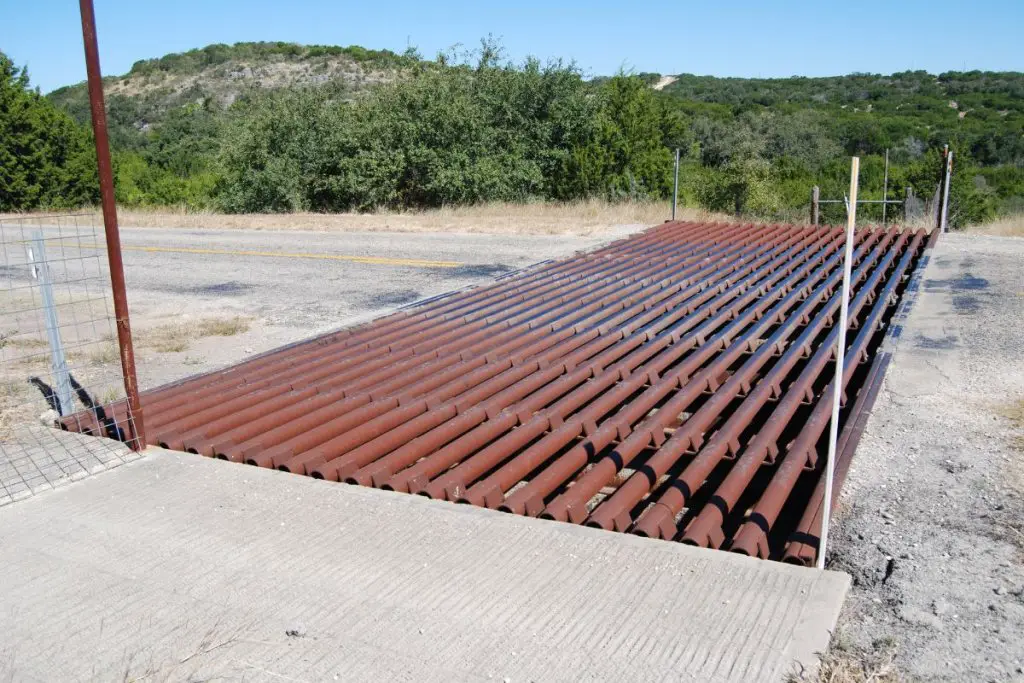
Flat-topped bars provide a less bumpy ride when crossing them and are advisable if the grid is on a high-traffic road or track and has many vehicles passing over it. As a compromise, you can always have a couple of pipes at the beginning of the “cattle” side of the guard, and then the rest can be the flat-topped variety.
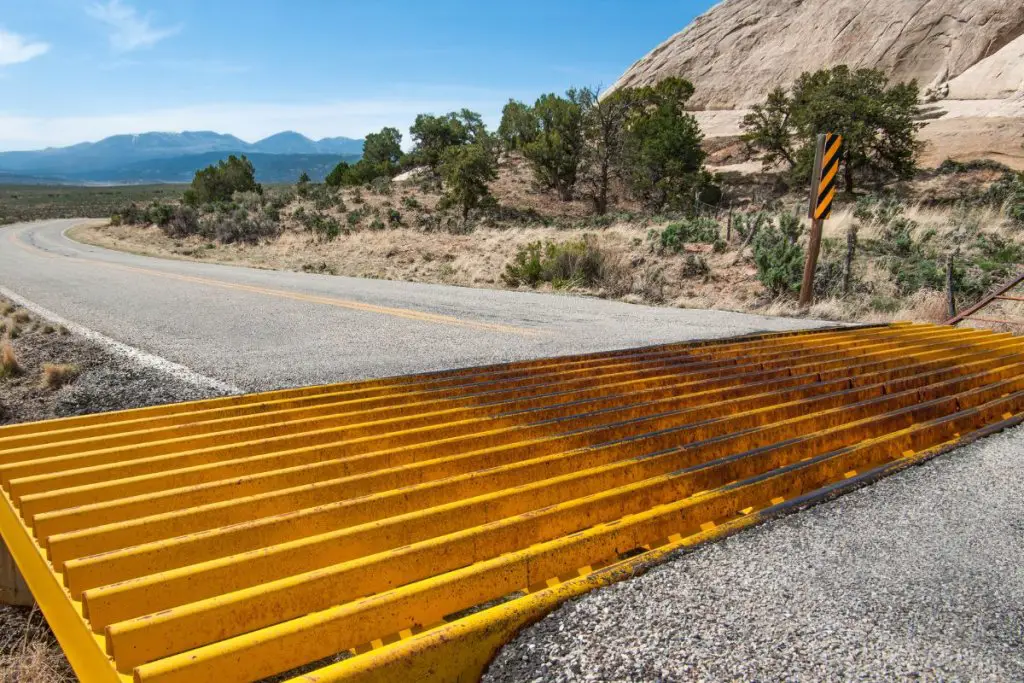
Vehicle widths tend to govern the width of the cattle guard. However, the guard should always be a minimum of eight feet long as bulls can jump about that distance with a run-up and the right motivation!
Fencing running along the entirety of both sides of the guard is recommended as cattle have been known to jump across them diagonally. Consequently, a typical guard should be at least eight feet square.
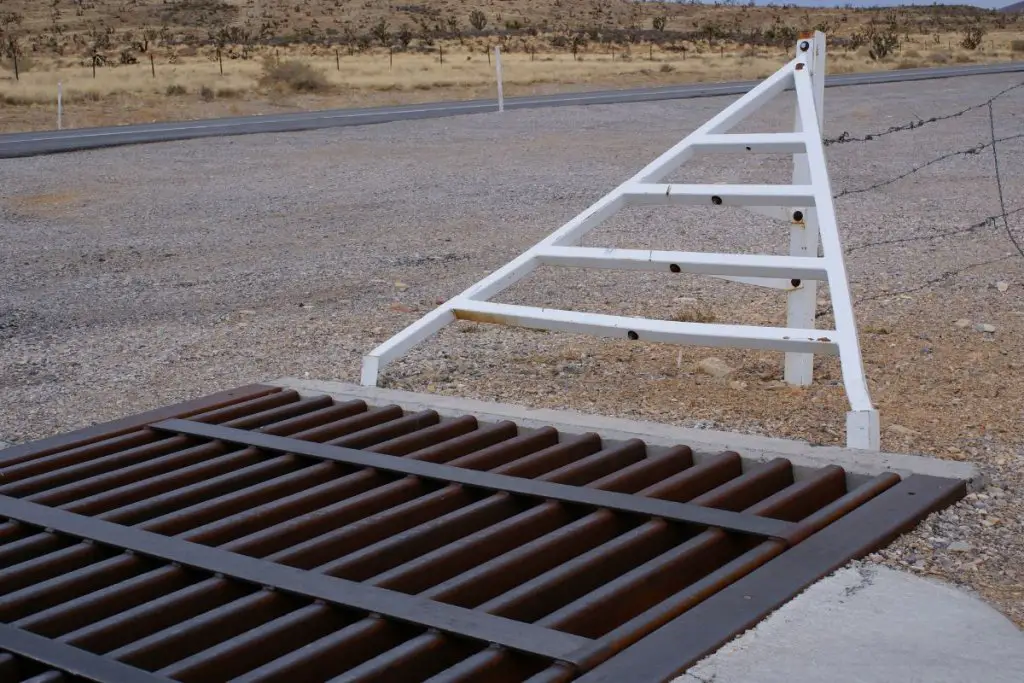
Many cattle guards have narrow bars that perpendicular about a foot in from the edge of the guard. These bars allow humans to walk across the grid. Dogs, cats, or other “soft-pawed” animals may also use them to cross.
The space underneath the bars should be cleared out regularly, especially if the gap is relatively shallow. Snow can accumulate here and, if left long enough, will reach the same height as the bars, thereby allowing animals to cross without difficulty.
How Do Cattle Guards Work?
Cattle guards work because cattle, sheep, and other livestock have poor depth perception. They have superb long-range binocular vision but have difficulty measuring distance immediately in front of and below them.
They see the gaps between the bars, cannot gauge the distance below because of their problems with depth awareness, and will not step forward.
The drop from the bars to the ground below should be a minimum of eight inches. Making the gap this size will prevent any severe damage to the limbs of cattle if they fall through.
If they do manage to cross the first gap, the discomfort the cattle feel when stepping on the small rail will deter them from taking a second step. A round-topped pipe, in particular, will be incredibly treacherous for a clumsy, flat-bottomed hooved cow and prevent any further attempts at a crossing.
Cattle guards are great deterrents, but they are not foolproof and you should use common sense.
For example, don’t think they will stop a cow trying to reach its calf or vice versa. They certainly won’t always put off a bull who may be acutely aware of some cows in heat grazing on the other side.
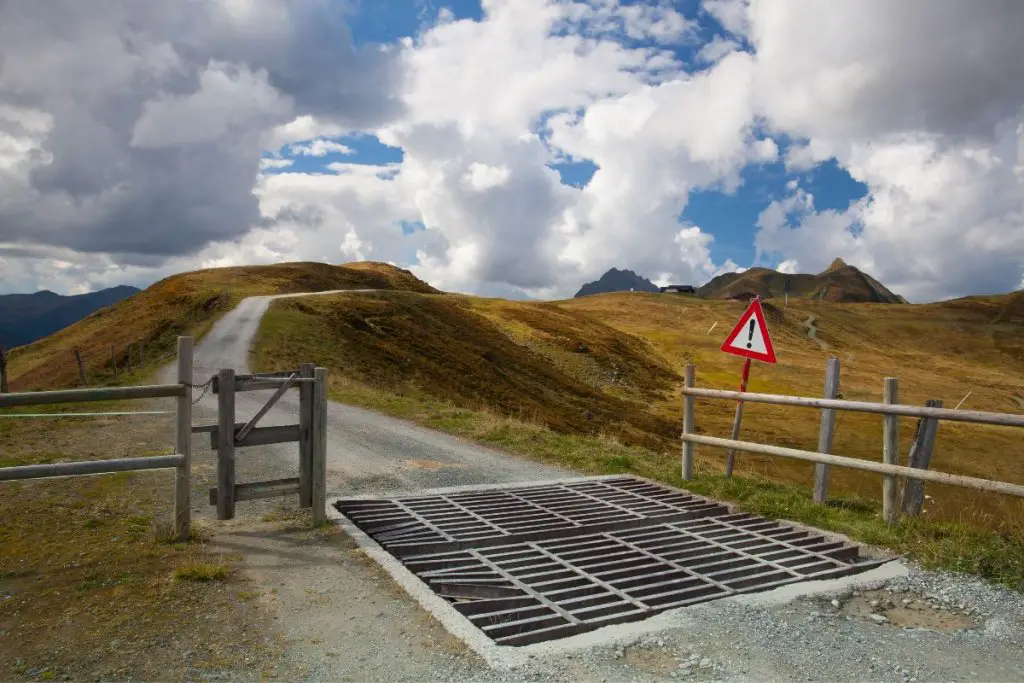
As mentioned previously, there are reports of stimulated bulls long-jumping up to eight feet!
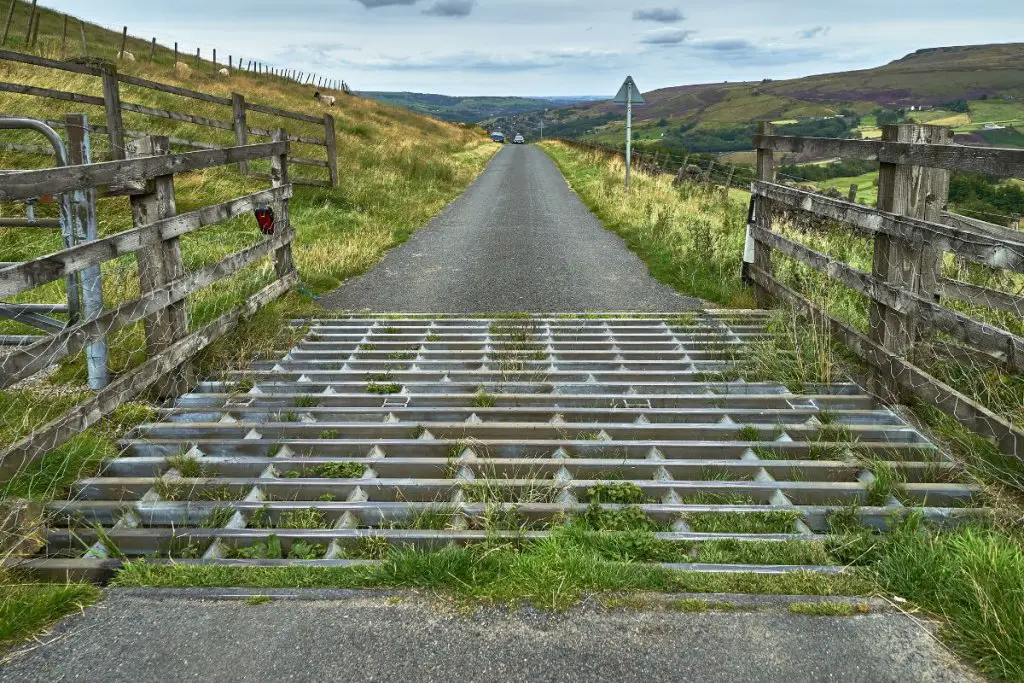
The Two Structures Used
Depending on the ground they lie on, these pipes will be fixed to a flat rectangular structure that runs around their extremities or be part of a more complex three-dimensional box construction.
There are two types:
| Shallow Hole | The basic grid structure is placed directly onto a depression or shallow hole in the ground. A guard of this kind would presumably only function as a temporary measure or if the land were not suitable for a concrete structure. |
| Box Type | The box or vault type structure is much more commonly used. The guard is placed and fixed onto a concrete-lined space dug out of the ground. |
Guards should have “skirts,” i.e., vertical sides to keep out earth, stones, and other debris. There should also be end pieces to prevent small animals from getting in and using them as nests.
However, the guard, or at least the top section, should be removable to allow debris or snow clearance when necessary.
Types of Cattle Guards and Alternatives
They would be used in situations where the fence line of a private property crosses into a public one, areas that a rancher doesn’t want his cattle in, such as separating cows from bulls, or one with potential dangers like a pit or lake. Guards are also used to keep cattle out of farmhouse living areas.
You usually find cattle guards on roads or tracks where it is impractical (and simply less annoying!) to constantly get out of your vehicle to open and shut a gate.
The answer to manually having to deal with the gate is to buy an electric one with remote control, but these are expensive and probably not cost-effective. They are prone to malfunction and can jam due to debris or snow. Electric gates can also freeze shut in colder climates.
Cattle guard design can vary. The rails used don’t have to be made of metal, and concrete is a common alternative.
Concrete Cattle Guards
Concrete cattle guards are cheaper than metal ones and often have lifetime guarantees because they won’t rust. They will be heavier, however, and this may cause problems if you wish to lift the girders out to clear out the pit area of debris.

The weight could also mean high shipping costs and increased difficulty placing the guard in the first place, especially if the grid location is difficult to access.
Metal Cattle Guards
Metal cattle guards are probably the best option, but you should only look at the top-quality ones. Galvanized steel cattle guards are incredibly resistant and give you the best longevity. However, they are costly, especially if you order a whole structure made of galvanized steel.

The most common option is to use a combination of the two. A concrete base and footings form the underground section, while steel pipes or bars will make up the visible grate.
Virtual Cattle Guards
On roads with a steady traffic flow, it is impractical to have a series of bars with gaps between them while entering and exiting a high-speed main highway. Virtual cattle guards are painted representations of cattle guards on these roads.
These accurate depictions of cattle guards are painted onto the road surface and are very effective in rural areas when placed at crossings from side roads onto busy roads.
Although they have proved very successful at preventing the ingress of cattle onto highways, there are cons, including weathering of the paint, rendering the illusion ineffective.
Another disadvantage would be that if one particularly ingenious, curious or shortsighted animal crosses the “guard,” others will follow instinctively.
Electric Cattle Guards
Electric cattle guards are an effective way of deterring even the most determined of cattle. They will also keep predators out. However, as with any outdoor mechanisms that require power, damage by the elements or animals is always a risk.
Warning signs will be necessary, and you can’t always rely on these being visible. Children and smaller animals, including pets, could also suffer a fatal shock if they were to cross without knowing the guard was “live”.
A Bump Gate
A comprise might be a “bump gate.” A bump gate is a hinged structure with a spring strong enough to resist most animals but not a vehicle.
They would have the same problems with debris and freezing, of course.
The tension of the spring is also something to take into account. For example, lighter farm vehicles like gators would not be heavy enough to open a bump gate with a spring set for a tractor or pickup truck.
There is a potential for vehicle damage after prolonged usage.
